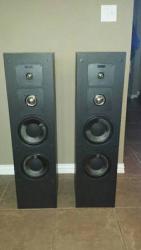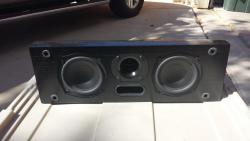-
Posts
580 -
Joined
-
Last visited
Content Type
Forums
Events
Gallery
Everything posted by japosey
-
I had a pair of the lower end version 1 or 2 of their entry level a few years back and didn't care for them.
-
It may be a due to what you are accustomed to listening to. The Fortes are a very forward sounding speaker in the mid to upper midrange when compared to some modern speakers. I have compared my Fortes to Paradigm Studio 100's, Energy RC-70s, Def. Tech towers and most recently to some Altec 508s. The biggest difference I found is that the Fortes do not have near the midbass punch these other speakers have. Maybe that is what you are noticing. The Fortes are very revealing and I find I prefer to use them with subwoofers. Just my 2 cents.
-

Sonance Virtuoso D800 Mono Subwoofer Amplifier - $80
japosey replied to japosey's topic in Garage Sale
Oops! $80 -
Up for for sale is a used working Subwoofer Amplifier. Item was tested and found to be in good working condition.. MSRP $590. Feature highlights 150 watts (program) Frontpanel volume, crossover, and phase controls Built-in non-defeatable limiter prevents overdriving woofers Line-level outputs for daisy-chaining multiple amplifiers Defeatable auto-on signal sensing Active current limit, short-circuit and speaker protection Specifications Power Output: 90 watts RMS @ 4 ohms Power Output (program): 150 watts @ 4 ohms Frequency Response: 35Hz - 250Hz + /- 1dB Total Harmonic Distortion: .05% 20Hz - 300Hz @ 8 ohms Signal-to-Noise Ratio: 95dB (w/22kHz A-WTG filter) Input Sensitivity: 45mV for 90 watts RMS @ 4 ohms (stereo inputs); 90mV (LFE input) Input Impedance: 20k ohms Power Consumption: 160 watts maximum (4 ohms, full power); 13 watts idle (no signal) AC Fuse: 4A (T4AL ~250V) Heat Output: 98 BTU/HR @ 8 ohms (rock music); 140 BTU/HR @ 4 ohms (rock music) Dimensions (WxHxD): 16 3/4" x 4" x 13 1/2" (425mm x 102mm x 343mm) Dimensions w/Rack Ears (WxHxD): 19" x 4" x 13 1/2" (489mm x 102mm x 343mm) Rack Space Requirements: 2U Shipping Weight: 20 lbs (9.1kg) each
-
Up for sale is my own personal Velodyne subwoofer. The unit is in perfect working condition and it is also in excellent xosme condition. I purchased the unit as-is about 7 years ago and had the amplifier repaired by Velodyne. It has been used in our children's TV room ever since with no issues.
-
Nice amp and a good price.
-
I needed some driver information (model #s) for the Heresy II and when did a search and found the Heresy II, I clicked on the datasheet and the specs for the Heresy III popped up. Just an fyi
-
Maybe I should have said conventional
-
The surrounds are rubber on this model. I believe in a previous model year they were foam. I've owned A7-500 and Valencias and I remember hearing these back 25 years ago. I prefer the A7 VOTTs and Valencias over these due primarily to the horn for midrange and highs. The upper midrange and highs on these are much more recessed. These do put out tremendous bass, mid bass and lower midrange though. I compared to my Fortes and I preferred the Altecs with sub turned off and the Fortes with my Velodyne Servo's on. The are really nice speakers and would be great for someone wanting a pair for stereo listening.
-
Up for sale is an excellent pair of Altec Lansing speakers. These speakers are not horn-loaded like the vintage Altecs, but are a more traditional design. The speakers are from the early 90's and feature 2 8" carbon fiber woofers, 2 1/2" titanium mids and 1" titanium tweeters. The cabinets are extremely ridged and are in still excellent condition. The cabinets are made with real wood veneer and not vinyl. I can't say enough about these speakers. Not only do they sound amazing, but they are extremely well made and feature high-end materials not often used in speakers at the time. What's also great about them is that they were manufactured right here in the good old USA! I can ship, but I'm sure shipping will be quite expensive given the amount of packaging they will require. I thought I would list the speakers here given all the speaker enthusiasts. I want to make sure they go to a good home where someone will take good care of them. Original retail price was $1,100. Here is a review by Stereo Review: Altec Lansing 508A Speaker System Review The Altec Lansing Model 508A is a three-way acoustic-suspension speaker system constructed in the popular tower format. Its ruggedly built, rigid wooden cabinet is attractively finished on all visible surfaces in walnut veneer. The cabinet measures 40-1/2 inches high and 11 inches square, plus an additional inch of depth for the removable grille. Each speaker weighs almost 60 pounds. The frequencies below 750 Hz are radiated by two 8-inch woofers with carbon-fiber cones. Middle frequencies are handled by a 21/4-inch polyimide-and-titanium dome driver, and there is a second crossover at 3,500 Hz to a 1-inch polyimide/titanium dome tweeter. The drivers are vertically aligned and mounted flush with the front panel for minimum boundary diffraction. The two gold-plated multi-way binding posts near the bottom of the rear panel, which also accept single or dual banana plugs, are recessed and angled for easy cable connection. Altec Lansing specifies the impedance of the Model 508A as 6 ohms, its sensitivity as 90.5 dB, and its bandwidth as 24 to 22,000 Hz. The system is designed for use with power amplifiers rated from 125 to 250 watts per channel. Price: $1,100 a pair. Lab Tests We placed the two Altec Lansing 508A speakers about 9 feet apart and 3 feet out from the wall behind them. As usual, we measured the room response with the microphone about 12 feet in front of the left speaker, on its forward axis, and approximately 30 degrees off the axis of the right speaker. The speakers were driven one at a time with a sine wave that was warbled over a one-third-octave range as it swept slowly from 20 to 20,000 Hz. The curves for both speakers, plotted automatically on a single sheet of logarithmic chart paper, followed similar trends but usually had opposite narrow-band variations over most of the frequency range. We averaged the curves visually to produce a single room-response curve. The room's high-frequency absorption characteristics had been determined previously with the aid of carefully calibrated reference speakers, and we applied the resulting response correction at frequencies over 10,000 Hz. Although this technique gives a reasonably good indication of a speaker's overall energy output into the listening space, room-boundary effects make it invalid at frequencies below a few hundred hertz. For this part of the spectrum, we measure the woofer output separately, with the microphone placed very close to the center of the cone. The resulting plot gives us the woofer's anechoic response, which we splice to the room curve to derive a corrected, averaged composite frequency response for the speaker. In this case, the bass-response curve closely matched the portion of the room curve between 80 and 500 Hz, resulting in a believable composite response curve over the full audio range. Its shape correlated well with what we heard from the speakers and showed that the Model 508A's output was flat within ±2.5 dB from 130 to 20.000 Hz. The output rose slightly at lower frequencies, by an additional 3 dB between 60 and 100 Hz, and fell off at 12 dB per octave below 60 Hz. Overall, the variation was ±4.5 dB from 35 to 20,000 Hz. The speaker's measured sensitivity was even higher than rated, producing a 92.5-dB sound-pressure level (SPL) at 1 meter with a 2.83-volt input of full-range pink noise. Minimum system impedance was about 4.5 ohms between 100 and 200 Hz, with a maximum of 14 ohms at 55 Hz and between 600 and 700 Hz. Over most of the audio range the impedance was 6 ohms or greater, justifying the speaker's 6-ohm rating. We measured bass distortion with the microphone close to one of the woofers. The constant input level of 2.12 volts corresponded to the signal that would create our reference 90-dB SPL. With that input, the woofer's distortion was between 0.5 and 1 percent from 50 to 300 Hz, rising to the range of 1.8 to 2 percent from 400 to 700 Hz. Distortion rose smoothly at lower frequencies, to 2.5 percent at 40 Hz, 4.6 percent at 30 Hz, and 6.5 percent at 24 Hz. We measured the system's high-frequency horizontal dispersion both on its forward axis and 45 degrees off it. The two curves began to diverge slightly above 6,000 Hz, reaching a 5-or 6-dB difference at 10,000 Hz and showing a large difference above 15.000 Hz. Our measurements indicated that the true (acoustic) crossover between the woofers and the midrange driver was closer to 500 Hz than the rated 750 Hz. The crossover to the tweeter could not be detected. As might be expected from its driver complement, the Altec Lansing Model 508A had an impressive power-handling ability. Feeding 100-Hz single-cycle bursts, our amplifier clipped at 1,190 watts into the speaker's 4.6-ohm impedance with no audible signs of distress from the speaker. Similar results were obtained at 1,000 and 10,000 Hz, with maximum levels of 655 and 820 watts, respectively. Comments The Altec Lansing Model 508A projects an aura of quality even before it is connected to a music system. The cabinet finish and workmanship are noteworthy, and it is one of a limited number of loudspeakers whose appearance is not at all degraded by removing its grille. The interior of the cabinet is obviously well braced and stiffened, since rapping any part of it with the knuckles produced a sound like rapping a block of concrete. But the only real proof of a speaker's performance is in the listening, and here the Model 508A lived up to expectations in full measure. Its overall sound quality was smooth and balanced, covering the full audio range without obvious emphasis or insufficiency. With certain program material (notably male announcers' voices on FM radio) there was a trace of warmth associated with the slightly emphasized output in the octave below 100 Hz. On the other hand, when the program contained any real bass content, the two woofers made themselves heard (and felt) in a way that cannot be matched by the many good speakers whose lower limits are around 50 Hz. The Model 508A could generate low-distortion, room-filling output down to the vicinity of 30 Hz, and its high sensitivity does not place unreasonable demands on the driving amplifier. Considering its size, the Model 508A is somewhat unusual in sounding as good at a 2-foot distance as at 15 feet. The contributions of its four drivers were so smoothly blended that it was impossible to localize each one audibly at distances greater than a few inches. This quality probably has little importance to most listeners, but it serves to demonstrate the successful integration of the system into what is effectively a single sound source. The Altec Lansing 508A is an excellent combination of first-rate sound, attractive styling, and reasonable size. We found nothing in its physical or acoustic characteristics that merited criticism.
-
Up for sale is a used enclosure that I'm parting out. I will sell the enclosure, grill and crossover for $25 plus shipping. The one blemish can be seen on the corner of the grill cloth.
-

Solid State amps known to sound good with Klipsch
japosey replied to mark1101's topic in Solid State
I ran one of the Rotel Class D multichannels on my Klipsch and it sounded pretty darn good. It utilized B&O's ICE design. I was surprised until one of the power supplies croaked. -
I will utilize auto room calibration and then once it's done, I always double check crossover points and speaker size. I generally leave volume levels alone, but will occasionally adjust one. EQ levels I also typically leave alone too. Auto calibration is a tool, but should not be used as a final end all for final setup.
-
Yes, you can refinish these subs. I've refinished a few. They have an oak veneer and you do have to be careful to not sand through it, but you can definitely refinish them. Sand them, stain them and seal them.
-
A couple of points. 1) Place your subs in opposite walls in your room to smooth out the response. 2) Place your subs on the same wall and/or same corners and it will increase output. Harman Kardon has produced white papers on a lot of topics and one of those topics is optimum sub number and placement. They have a couple of papers you should check out - the first one on the page and the 5th one. http://www.harman.com/EN-US/OurCompany/Innovation/Pages/WhitePapers.aspx
-
It does not have a tuner.
-
This would make a very nice two channel pre-amp. It's being offered at 1/10th of the original price.
-

What line do the Klipsch KV Center Channels go with?
japosey replied to japosey's topic in Home Theater
Thanks for all the responses. The literature I have from the early 90's lists all the KG line including the KG 2.2V. There was no reference to the KV center channels. I assume they began producing the KV line since they were a little more streamlined and would fit better above or below a TV. I imagine they would work with several lines from the 90's given the similarity of the tweeters. -
Up for sale is a really nice set of bookshelf speakers. As you can see, the cabinets and grills are in excellent condition as well are the drivers. FREQUENCY RESPONSE: 50Hz-20kHz(+-)3dB SENSITIVITY: 90dB @ 1watt/1meter POWER HANDLING: 50 watts maximum continuous (250 watts peak) NOMINAL IMPEDANCE: 8 ohms TWEETER: K-86-K 1" (2.54cm) Phenolic dome compression driver HIGH FREQUENCY HORN: Exponential Cone WOOFER: K-1007-K 6.5" (16.51cm) Injected Carbon Graphite cone ENCLOSURE MATERIAL: Medium density fiberboard construction (MDF) ENCLOSURE TYPE: Bass reflex via rear-mounted port DIMENSIONS: 13" (33cm) x 9.25" (23.5cm) x 9.25" (23.5cm) WEIGHT: 15 lbs. (6.8kg) FINISHES: Walnut Oil, Oak, Oil, Oak Clear, Finished Black veneers, White vinyl BUILT FROM: 1992 BUILT UNTIL: 1994
-
Just curious
-
I have a KV-2 center channel speaker in very good condition. The speaker features 5.25" mids and a 1" tweeter. Cabinet is in great condition. I see no dings or dents. The grill looks to be in really good condition. I'm sure you could find a small imperfection somewhere, but I think the speaker looks great. Shipping will be fixed at $15 for continental US. So, $60 shipped and it's yours! Specs FREQUENCY RESPONSE: 75Hz-20kHz(+-)3dB SENSITIVITY: 92dB @ 1watt/1meter POWER HANDLING: 75 watts maximum continuous (375 watts peak) NOMINAL IMPEDANCE: 8 ohms TWEETER: K-89-KV 1" (2.54cm) Polymer dome compression driver HIGH FREQUENCY HORN: Exponential Cone WOOFER: Two K-1016-SV 5.25" (13.34cm) Poly cones ENCLOSURE MATERIAL: Medium density fiberboard construction (MDF) ENCLOSURE TYPE: Bass reflex via front-mounted port DIMENSIONS: 6.75" (17.2cm) x 20" (50.8cm) x 6.6" (16.8cm) WEIGHT: 13 lbs. (5.9kg) FINISHES: Whitewash, Light Oak, Medium Oak, Cherry, Walnut, Black Satin BUILT FROM: 1993 BUILT UNTIL: 1997
-
Up for sale is a Rotel RSP-1066 in great condition. All tested and all is good. Cosmetically, the unit is great condition as well. No remote, manual or box included. Specifications RSP-1066 surround preamp-processor Audio Section Surround modes: Dolby Pro Logic II, Dolby 3-, 5-, & 7-channel stereo, Dolby Digital, Dolby Digital EX, DTS, DTS-ES Matrix, DTS-ES Discrete, DTS Neo:6, Music DSP Analog inputs: 8 RCA line-level (2-channel), RCA (7-channel) Digital inputs: 3 coaxial, 2 TosLink Analog outputs: RCA L/R Front, Center 1,Center 2, L/R Rear, Center Back 1, Center Back 2, Sub 1, Sub 2, Zone 2 L/R, Tape, Video 1,2,3 Digital outputs: 1 coaxial, 1 TosLink Other connectors: COM I/O, Zone 2 remote, External remote, Dual12V trigger, Dual IR out Frequency response: 10Hz-95kHz, ±1dB, line level; 10Hz-20kHz, ±0.3dB, digital Signal/noise: 95dB (stereo analog), 92dB (Dolby Digital, DTS), both IHF A-weighted THD: <0.05% IM distortion: <0.05% Input sensitivity/impedance: 200mV/47k?, line level Video Section Inputs: 5 composite, 5 S-video, 2 component Outputs: 4 composite, 4 S-video, 1 component Frequency response: 3Hz-10MHz, ±3dB Signal/noise: 45dB Dimensions: 17.01" x 4.76" x 13.43" (WxHxD) Weight: 16.7 lbs Price: $1499 Manufacturer Rotel 54 Concord Street North Reading, MA 01864 tel. show contact info www.rotel.com
-
I'm in Denton, TX and would be happy to ship. Shipping to KC would likely be $15-20.
-
Up for sale is a pair of RB-51 speakers that are in very good condition. No dents and/or dings. They work perfectly.
-
I picked up a nice Pioneer cassette deck from the early 80's that I'm re-furbing and I actually bought a Jackson Brown cassette to use while testing the unit.
























